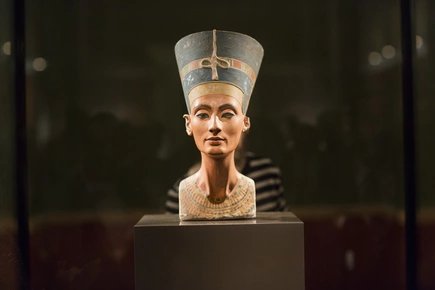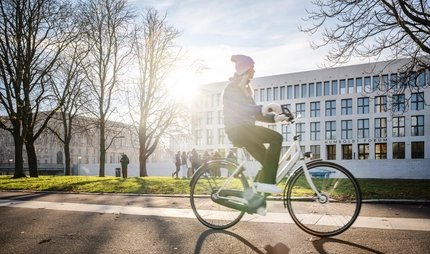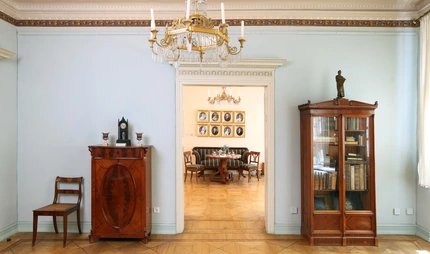
Industrial culture by bike
Cycling to the cathedrals of Berlin's industrial culture
Immerse yourself in the exciting history of Berlin - by bike! The carefully designed cycle routes from the Berlin Centre for Industrial Heritage take you to fascinating places of industrial heritage, from historic factories and railway stations to impressive waterworks and innovative industrial sites. On these tours, you will experience how industry, architecture and urban development have shaped Berlin's unique face - then and now.
Steam engines were the first - initially used to drive water pumps in mining, they heralded the age of mass production at the beginning of the 19th century. Companies such as Siemens, AEG and Borsig emerged and employed more and more workers. Berlin's population doubled within a few years. You can explore the traces of this time by bike on several themed routes.
The tours at a glance
Route 1
The cycle route "Warm light and cool beer" combines Berlin's history as an "electropolis" with its tradition as a brewery metropolis by exploring the sites of the electrical industry and historic breweries in Prenzlauer Berg. Pioneers such as Siemens and AEG shaped the city with imposing industrial buildings, while innovative master brewers capitalised on the increasing demand for beer in the growing metropolis. Along the route, visitors discover impressive factories and technical monuments that bring Berlin's transformation into a modern industrial city to life.
Route 2
The cycle route "Production and ammunition" takes you to the north-west of Berlin and shows how Spandau was shaped by the military armaments industry and the industrialisation of Siemensstadt. From the first rifle factory in 1722 to the creation of modern residential and factory complexes, Spandau developed into an important centre of military and industrial architecture. Along the route, visitors will discover impressive fortifications, industrial buildings and evidence of the urban development changes brought about by the large corporations.
Route 3
The cycle route "Water and electricity" leads along the River Spree from Treptow to Oberschöneweide, the historic centre of Berlin's electrical industry, and through Volkspark Wuhlheide back to the starting point. At the end of the 19th century, an important industrial area was created here with the first three-phase power station in Europe, extensive factories and new housing estates for the workforce. Today, many of the impressive industrial complexes are listed buildings and bear witness to Berlin's rise as an electropolis.
Route 4
The cycle route "Innovation and elegance" leads through Charlottenburg, Tiergarten and Mitte to important research facilities, innovative industrial buildings and elegant architecture from the late 19th and early 20th centuries. In a time of industrial upheaval, new universities, modern power stations and advanced infrastructure were built, driving Berlin's transformation into a cosmopolitan city. Along the route, you can discover magnificent buildings and functional industrial architecture that reflect the self-confidence and innovative power of this era.
Route 5
The cycle route "Railway and runway" leads through Kreuzberg, Tempelhof and Schöneberg to Berlin's historic transport arteries, which shaped the city from the 19th century to the post-war period. With canals, railway lines and later motorways and airports, Berlin developed into a central trade and transport hub. Along the route, you can discover impressive railway stations, Tempelhof Airport and relics of the city's industrial and transport history.
Route 6
The cycle route "Nature and infrastructure" leads from Westkreuz S-Bahn station via the Berlin Exhibition Centre to Grunewald and along the Havel to Wannsee and shows the connection between nature, urban development and infrastructure. With Berlin's rapid industrialisation, new residential areas, waterworks, leisure areas such as the Wannsee lido and technical structures such as the radio tower were built. Along the route, nature, historical buildings and relics such as the Teufelsberg reflect Berlin's industrial and political developments.
Route 7
The cycle route "Flyers and skylarks" leads across Tempelhofer Feld, which was transformed from an 18th century military parade ground into an important airport and is now the largest open space in the world. Along the route, visitors encounter impressive architecture such as the monumental airport building from 1936 as well as relics from aviation and Nazi history. Today, Tempelhofer Feld is also a valuable natural area where rare bird species such as the skylark have found a new home.
Route 8
The cycle route "Canal and Industry" leads from Lankwitz S-Bahn station along the Teltow Canal to Wannsee and shows the development of an innovative industrial landscape in south-west Berlin. At the beginning of the 20th century, modern infrastructure such as electric tow locomotives, canal power stations and industrial railways were built along the canal, decisively promoting Berlin's growth. During the division of Germany, the canal marked the border; today it once again connects historic industrial sites and new developments.



